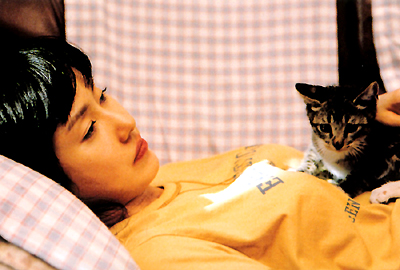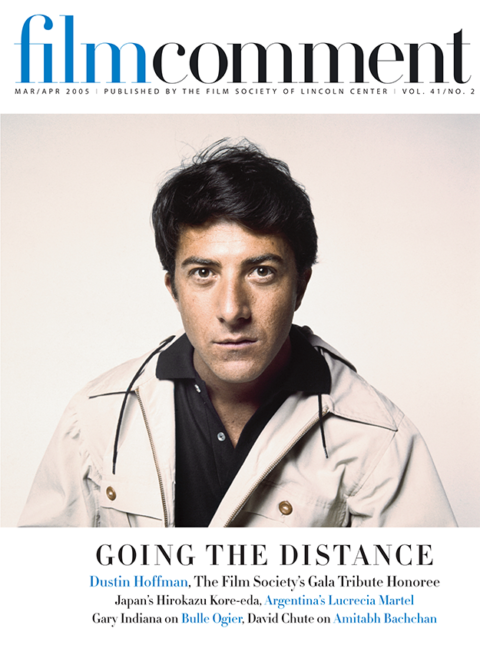
This Charming Girl
Rumbling and grumblings about the future of the Sundance Film Festival continued apace at the 2005 edition. For years, rumors have circulated about the festival looking for larger digs once its contract with Park City is over. But Sundance’s problems won’t be solved by a change of venue; they might even be exacerbated by a more accommodating location. No, the big question for the festival is whether to take the course of least resistance—showcasing primarily the kind of independent film Hollywood finds sexy and potentially profitable—or return to its original raison d’être—focusing on films that break with the Hollywood model in content and form.
Admittedly, it’s not always easy to tell one from the other, and some of the most interesting films in the festival’s history—sex, lies, and videotape or Reservoir Dogs—are populist successes with a foot in both worlds. Still, when a film like the routine inner-city inspirational Hustle and Flow hogs the spotlight—not because it’s good but because it’s the object of a bidding war—and a film like Police Beat goes virtually unnoticed, something is seriously wrong with Sundance and the discourse about independent film it generates. On the street, at the parties, and late at night in the condos, people talk about deals and what movie star they saw with bags of swag rather than about the movies themselves or in relation to culture and politics—to the extent that one feels uncool dwelling on a film merely because it challenges preconceptions of what movies can do or because its director is stunningly talented. Sundance was never without problems, but today it’s a far cry from the heady early Nineties when one weighed the virtues of Safe against Kids and the festival itself worried that it would be perceived as the spawning ground of the “Gay New Wave.”
It’s not that Sundance actively sold out to Hollywood so much as it put up no resistance when Hollywood invaded bearing bags of gold and took over the festival for its own ends while scores of embedded entertainment reporters gushed about the brave new world of independent film. No one died, as far as I know, because they did not become famous overnight, but many were wounded in that they became dissuaded from their personal vision of cinema when it was not in line with what the invaders believed film should be—something they could make a buck with. (The analogy is to the Bush administration’s fantasy of what would happen in Iraq, not to the actuality.) I don’t think that the festival powers that be are particularly happy with the current situation, but they’ve been laissez-faire for so long, it’s hard to stop now. My radical solution for cutting back the crowds of suits and hanger-ons, the corporate branding, and the entertainment news coverage would be to internationalize the main competition. Since festivals are identified with their main competition, Sundance could transform itself pretty quickly from a de facto tool of the industry to a champion of worldwide progressive film culture. The U.S. doesn’t have a big world-class film festival on the level of Cannes or Toronto (although the latter has its own problems with Hollywood junketeers). Tribeca is gunning to become just that, but if Sundance wanted to move in the same direction, its reputation and experience would be an advantage. In any case, subtitles would be to industry honchos as garlic is to vampires.
This year, in an effort to create a bit of heat around foreign films and make the festival more appealing to international sales agents, Sundance turned their world cinema sidebars into separate although far from equal competitive categories. The halfway measure produced a fine roster of international art films that festivalgoers continued to regard as second-class citizens. Park City locals, however, crowded out of the over-hyped Amerindies by Industry-package pass holders, tried the foreign films and often discovered they got the best deal. This Charming Girl by Korean director Lee Yoon-ki was one of the strongest films I saw, but I never would have made time for it had I not been persuaded by a middle-aged, film-savvy Park City resident I ran into one night on the check-out line at Albertson’s supermarket.
A Pusan prizewinner, This Charming Girl is an unusually subtle feminist critique made by a male director within one of the world’s most misogynist film cultures. Lee’s heroine is a young postal worker, grieving the death of her mother, the only member of her family who did not condemn her for walking out on her husband on their wedding night. Driven to the edge of suicide by loss, loneliness, and her inchoate sense that there is something wrong when almost every man she encounters acts as if it’s his prerogative to tell her what to feel, believe, and do, she saves herself by her stubborn trust in her own impulses. This Charming Girl is a minor miracle, not just for its feminist politics but also for Lee’s filmmaking precision and his ability to convey the unspoken and often unconscious deployment of power.
Another small triumph, Live-In Maid, the debut feature by Argentine filmmaker Jorge Gaggero depicts the effect of Argentina’s economic meltdown on the relationship between a formerly wealthy businesswoman and her servant of 30 years. Among the other foreign standouts: Jun Ichikawa’s Tony Takitani, Michael Winterbottom’s 9 Songs, and Rupert Murray’s documentary Unknown White Male. I’ll be returning to them here and in the pages of FILM COMMENT when they’re released later this year.








